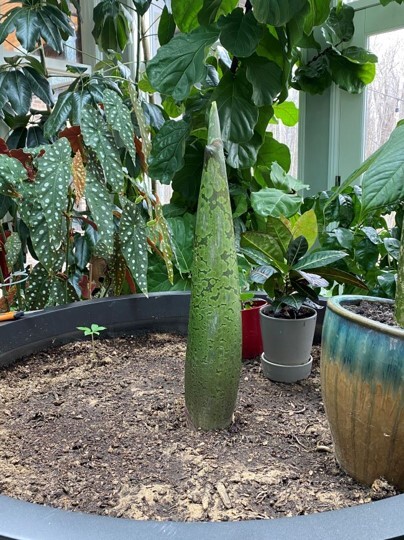Image


An unprecedented event is about to unfold in Dexter. Local resident Kevin Hauser is about to make history with the blooming of an Amorphophallus Titanum, commonly known as the "corpse flower," within his home conservatory.
The corpse flower is known for being the largest flower in the world and emits a smell akin to rotten flesh during its rare blooming period. The blooming of Hauser's corpse flower is not only a momentous occasion for him and his family but also for botanical enthusiasts and conservationists worldwide.
The Amorphophallus Titanum, or "Corpsy" as the Hauser family affectionately call it, is critically endangered, with only about 500 of these magnificent plants remaining in the wild, primarily on the island of Sumatra, and approximately 2,000 in conservation worldwide across various universities and botanical gardens.
What makes Hauser's plant exceptionally noteworthy is the rarity and significance of this event. "There have been eight non-institutional growers to flower this plant in the U.S.," he explains. "It is believed this will be the first flowering globally to occur inside a residential home, and only the second flowering in the U.S. this year."
 Kevin Hauser's corpse flower as it looks 2-3 weeks before blooming. Photo courtesy of Kevin Hauser.
Kevin Hauser's corpse flower as it looks 2-3 weeks before blooming. Photo courtesy of Kevin Hauser.This bloom is particularly special as it represents not just a botanical marvel but also a conservation effort, showcasing a plant species on the brink of extinction due to deforestation.
Hauser's journey with "Corpsy" began six years ago when he acquired a two-ounce corm from a cloned specimen in North Carolina. The flowery endeavor is somewhat of a family affair with Hauser's two daughters, Rainey and Evelyn, watching their dad tend to this mysterious plant for so long. Little could they imagine how Kevin's quiet efforts are about to burst forth in local, national, and global acclaim.
Hauser explains the plant grows from a "corm" (like a potato), producing a large, leafy green plant called a "leaf" that can last over a year before declining. The corm then goes dormant for several months until re-emerging as an even bigger leaf (up to 15 feet tall). Once the corm has stored up enough energy, it can bloom. This usually takes at least seven years, and it won't bloom again for several years until it has enough energy to do so again.
Corms can weigh over 250 pounds. Hauser's weighed 80 pounds at its last dormancy and required two people to carry it. The odor from which the plant gets its common name is quite pungent and can be smelled a half mile away. In addition, the core temperature rises to 98 degrees, a trick to fool pollinator insects into thinking it is a dead animal.
"I was able to do this because I have a conservatory in the house with a 25-foot glass ceiling and climate control," he notes. "Time and patience and repotting every cycle in increasingly larger pots. It needs tons of potassium-rich fertilizer to do well. Lots of heat, sunshine, and water. I make my own soil using aspen woodchips and sand harvested from my property, mixed with peat moss."
The corpse flower blooming is a rare event, with only about 800 recorded blooms worldwide in the last 130 years. Hauser explains these plants bloom only once every 7-10 years, making each event a spectacle that can attract tens of thousands of visitors eager to witness the extraordinary size and experience the unique odor of the flower. Michigan has recorded only six such blooms, all within the major botanical gardens and universities of MSU, UofM, Frederik Meijer Gardens, and Grand Valley State.
Kevin Hauser has extended an open invitation to the public for a limited viewing of the blooming, expected to occur in 2-3 weeks from March 18. Those interested in witnessing this rare event can contact him at [email protected].
The blooming of "Corpsy" in a private residence is a significant milestone in the world of botany and conservation, offering an intimate glimpse into the lifecycle of one of the planet's most intriguing and endangered plants.